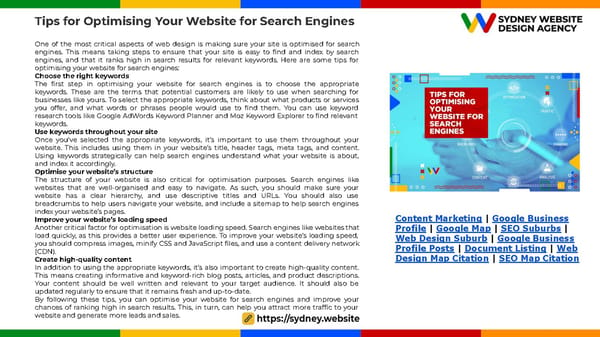Tips for Optimising Your Website for Search Engines One of the most critical aspects of web design is making sure your site is optimised for search engines. This means taking steps to ensure that your site is easy to find and index by search engines, and that it ranks high in search results for relevant keywords. Here are some tips for optimising your website for search engines: Choose the right keywords The first step in optimising your website for search engines is to choose the appropriate keywords. These are the terms that potential customers are likely to use when searching for businesses like yours. To select the appropriate keywords, think about what products or services you offer, and what words or phrases people would use to find them. You can use keyword research tools like Google AdWords Keyword Planner and Moz Keyword Explorer to find relevant keywords. Use keywords throughout your site Once you’ve selected the appropriate keywords, it’s important to use them throughout your website. This includes using them in your website’s title, header tags, meta tags, and content. Using keywords strategically can help search engines understand what your website is about, and index it accordingly. Optimise your website’s structure The structure of your website is also critical for optimisation purposes. Search engines like websites that are well-organised and easy to navigate. As such, you should make sure your website has a clear hierarchy, and use descriptive titles and URLs. You should also use breadcrumbs to help users navigate your website, and include a sitemap to help search engines index your website’s pages. Improve your website’s loading speed Content Marketing | Google Business Another critical factor for optimisation is website loading speed. Search engines like websites that Profile | Google Map | SEO Suburbs | load quickly, as this provides a better user experience. To improve your website’s loading speed, Web Design Suburb | Google Business you should compress images, minify CSS and JavaScript files, and use a content delivery network Profile Posts | Document Listing | Web (CDN). Create high-quality content Design Map Citation | SEO Map Citation In addition to using the appropriate keywords, it’s also important to create high-quality content. This means creating informative and keyword-rich blog posts, articles, and product descriptions. Your content should be well written and relevant to your target audience. It should also be updated regularly to ensure that it remains fresh and up-to-date. By following these tips, you can optimise your website for search engines and improve your chances of ranking high in search results. This, in turn, can help you attract more traffic to your website and generate more leads and sales.
 Web Design That Produces Results Based On The Business Goals Page 9
Web Design That Produces Results Based On The Business Goals Page 9